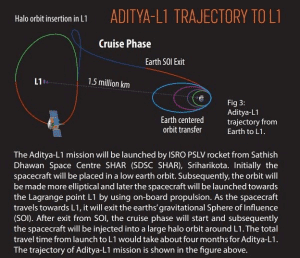TAG: GS 3: SCIENCE AND TECHNOLOGY
THE CONTEXT: The study of the Sun’s inner corona remains a pivotal area of research for solar physicists. Leveraging rare celestial events like solar eclipses and advanced space missions such as India’s Aditya L1, scientists aim to deepen our understanding of the solar atmosphere and its dynamics.
EXPLANATION:
Solar Eclipses as Observational Windows:
- Solar eclipses provide a unique opportunity for solar physicists to study the Sun’s inner corona.
- During a total solar eclipse, the Moon acts as a perfect occulting agent, blocking the solar disk and revealing the otherwise elusive corona.
- This alignment allows for direct observation of important dynamics within the solar atmosphere, offering insights into phenomena like solar flares and coronal mass ejections.
The Role of Indian Solar Physicists in Eclipse Observations:
- A team of Indian solar physicists is currently in the United States to observe the April 8 total solar eclipse.
- Led by experts from the Aryabhatta Research Institute of Observational Sciences (ARIES), the team aims to conduct multiple experiments and observations to capture images of the solar corona, particularly during the totality phase.
- By analyzing these observations, scientists hope to gain valuable insights into the behavior of the solar atmosphere.
Aditya L1 Mission: Enhancing Solar Study Capabilities:
- Aditya-L1 is a coronagraphy spacecraft designed and developed by the Indian Space Research Organisation (ISRO) to study the solar atmosphere. It is India’s first dedicated solar mission.
- The spacecraft will be orbiting at about 1.5 million km from Earth in a halo orbit around the L1 Lagrange point between the Earth and the Sun.
- India’s Aditya L1 spacecraft, positioned at Lagrange Point 1 of the Earth-Sun system, offers a complementary platform for solar study.
- Equipped with seven payloads, including coronagraphs and spectrometers, Aditya L1 enables continuous and uninterrupted observations of the Sun’s corona.
- While ground-based observations during eclipses provide valuable data, Aditya L1 enhances our ability to study the Sun’s atmosphere under different conditions and from a unique vantage point.
- Unlike ground-based observations, Aditya L1’s view remains unobstructed during solar eclipses.
- Positioned at Lagrange Point 1, approximately 1.5 million kilometers from Earth, the spacecraft’s orbit ensures that it remains unaffected by the eclipse phenomena occurring on Earth.
- This uninterrupted view allows scientists to capture crucial data on the solar corona, complementing observations made from terrestrial observatories.

Experiments and Observations during the Eclipse:
- The Indian team plans to conduct high-cadence narrowband imaging observations of the solar corona using specific emission lines, such as Fe XIV 5303 °A.
- By capturing both on-band and off-band observations, scientists aim to investigate high-frequency oscillatory and variable phenomena within the solar atmosphere.
- These experiments not only contribute to our understanding of solar dynamics but also facilitate the calibration of instruments onboard Aditya L1, improving the accuracy of space-based observations.
Unique Insights from Solar Eclipses:
- Studying the solar atmosphere during a total solar eclipse offers distinct advantages over traditional observations.
- The natural occultation provided by the Moon allows for clear visualization of the inner corona, which is otherwise challenging to observe due to scattered light in artificial coronagraphs.
- By capitalizing on these rare events, scientists can uncover new insights into solar phenomena and refine our understanding of the Sun’s behavior throughout its 11-year solar cycle.
Solar Eclipse:
- Solar eclipses occur when the Sun, the Moon, and Earth line up, either fully or partially. Depending on how they align, eclipses provide a unique, exciting view of either the Sun or the Moon.
- A solar eclipse happens when the Moon passes between the Sun and Earth, casting a shadow on Earth that either fully or partially blocks the Sun’s light in some areas.
- This only happens occasionally, because the Moon doesn’t orbit in the exact same plane as the Sun and Earth do.
- The time when they are aligned is known as eclipse season, which happens twice a year.

